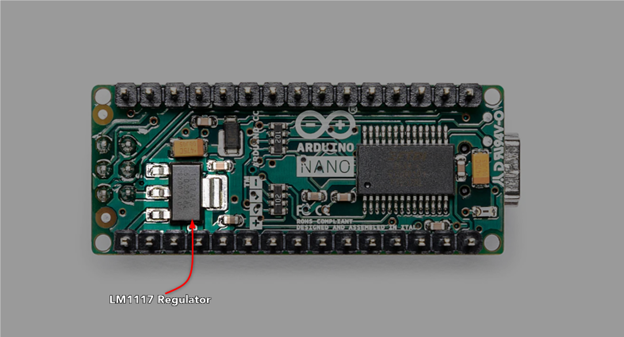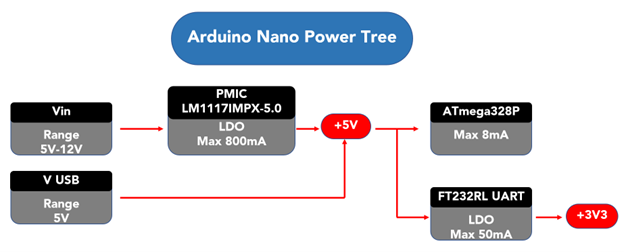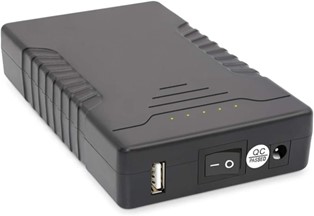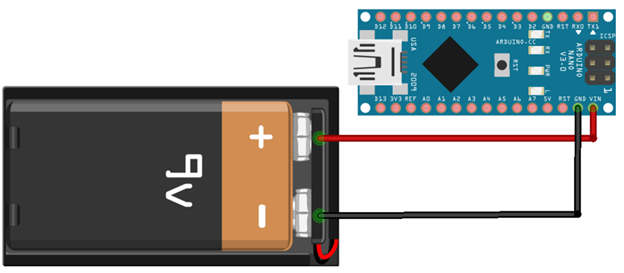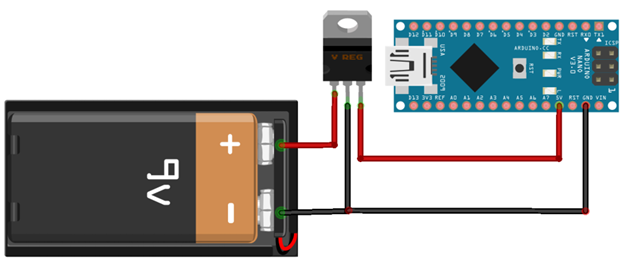Arduino Nano is a compact power conserving microcontroller board. Working of Arduino Nano is similar to UNO board as both have working voltage of 5V and use the same ATmega328 series microcontroller. Power requirements of both these boards are somewhat similar. Here we will explain battery interfacing with Arduino Nano.
Can Arduino Nano Run on Battery
Yes, Arduino Nano can be connected to a battery. It is possible to power an Arduino Nano using batteries, as the device has a voltage regulator that allows it to operate within a wide range of input voltages. The input voltage to the Nano should be between 7 and 12 volts, and a common choice for battery power is to use four AA batteries, which can provide a stable voltage of 6 volts.
However, it’s recommended to use a voltage regulator to drop the voltage down to 5V which is the ideal voltage for the Arduino board. This will protect Arduino Nano from voltage fluctuations and prolong the life of the batteries.
It’s also important to note that if you are using the Nano for a project that requires a lot of power or will be running for an extended period, you may need to use a larger battery or power source to ensure that the device has enough power to operate properly.
Different Ways to Power Arduino Nano
Arduino Nano has 3 different ways of power:
- USB Port
- VIN Pin
- 5V Pin
The Arduino Nano working voltage is 5V. It has an on -board voltage regulator (LM1117) which converts incoming voltage to regulated 5V. Power from the VIN pin is regulated using this LDO regulator. To connect Arduino Nano with battery we have to look at the power requirements of this regulator.
LM1117 specifications:
| Regulator | Output Voltage | Max Input Voltage | Max Output Current |
| LM1117 | 5V | 20V | 800mA |
Given image represents the Arduino Nano power tree:
Power Arduino Nano Using a Battery
To power Arduino Nano using a battery we can use either the USB port or the VIN and 5V pin available onboard. Following three ways allows us to interface a battery with Arduino Nano:
- USB Port with rechargeable power bank
- VIN with 9V battery
- 5V pin with 9V battery and a voltage regulator
USB Port with Power Bank
To power the Arduino Nano with a battery using a USB port, we can try the rechargeable power bank. Most power banks have USB 5V output which provides us with regulated 5V that can run Arduino Nano for long hours.
VIN with 9V Battery
To power the Nano with a 9V battery we can directly apply it on the VIN pin. As this pin is connected to an onboard LDO regulator which can take voltage up to 16V. So, Arduino Nano can easily be powered through this pin and this is the safest way of powering Arduino Nano with a battery.
5V Pin with 9V Battery
Last way of using a battery with Nano is through a 5V pin. This is by far the most complex way of powering the Nano as 5V is connected to the output terminal of the LDO regulator. Any slight increase in input voltage will result in damage to the regulator. This is because the output terminal voltage becomes greater than the input of the regulator.
To avoid this, we have to use an external regulator chip with Arduino Nano and battery. This will regulate the 9V to 5V working voltage.
Warning: Try not to use this 5V for powering Arduino boards as this is designed for output purpose. Also don’t apply more than 5V directly to this pin.
Different Batteries That Can Power Arduino Nano
For powering Arduino Nano there are multiple kinds of batteries that can be used. One popular choice is using a 9V battery, which can provide a stable voltage and is relatively small and easy to use.
Another option is to use a series of AA or AAA batteries, which can be connected to provide the necessary voltage for the board. Lithium-ion batteries are also a good option as they have a higher energy density and can last longer, but they are slightly more expensive and require a special charging circuit. Some people even prefer using rechargeable batteries such as NiMH (Nickel metal hydride) or Li-ion batteries which can be recharged using USB.
A lead-acid battery is also an option for providing power to an Arduino Nano, but they are larger and heavier than other types of batteries. If your project will be mobile or portable and you need to power the Arduino for longer hours, then the usage of Lithium Polymer Battery is the best solution as they are lightweight and have a high energy density, capable of providing the board with enough power for several hours.
It’s also important to keep in mind that different types of batteries have different voltage levels and current capabilities, so it’s important to choose a battery that is compatible with your specific project and the requirements of the Arduino Nano.
Conclusion
Arduino Nano is a compact power conserving microcontroller board. To make the project portable we can use external rechargeable batteries with Arduino that can power it. This article explains the requirements and ways to power Nano with a battery.

